Following the Terminator Part 3
By Joseph Cohen
First published Crux Aug- Sep 2007
Day 6
The terminator has moved faster and exposed the five major eastern seas. Mare Foecunditatis, the dark Mare Tranquillitatis and Mare Serenitatis separate the heavily cratered southern hemisphere from the less heavily cratered northern hemisphere and at this stage the seas and lakes appear to dominate the northern hemisphere. The straits between Mare Tranquillitatis and Mare Serenitatis separate the eastern Taurus mountain area from the western Haemus mountains. The darker floor of Mare Tranquillitatis appears to have flooded through the straits and spread along the coast of Mare Serenitatis. Several structures stand out in the darkness west of the terminator. A review of the structure seen in earlier days will show changes due to different illumination angles. Ray systems e.g. Proclus, Stevinus and Snellius tend to hide the craters involved. Some structures almost disappear; others brighten, whilst some remain dark.
Southern Hemisphere
To explore the southern hemisphere, first find PICCOLOMINI (Fig. 1, 1) lying south of Mare Nectaris with an interesting and varied group of craters. Piccolomini is a well formed crater with a prominent central mountain. The ALTAI scarp (Fig. 1, 2) with its illuminated east facing cliff will lead you to it.
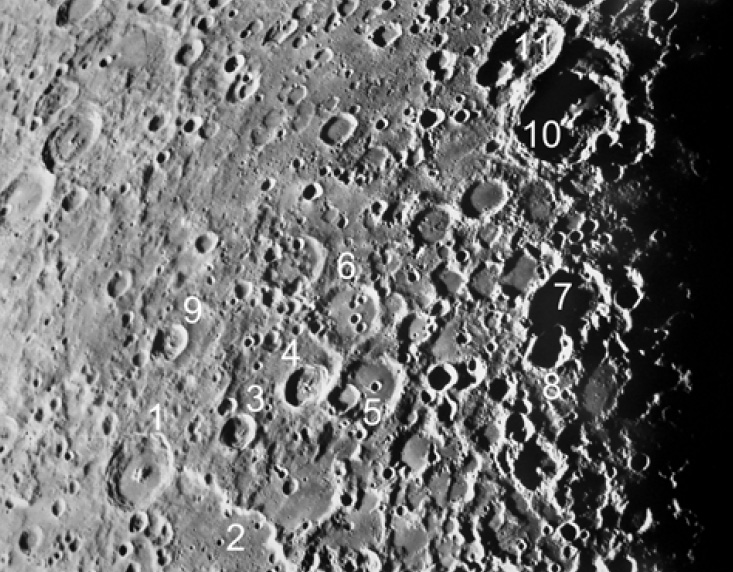
Figure 1 :
South-central region of the 6-day-old Moon (South up)
1 Piccolomini 2 Altai Scarp 3 Rothmann 4 Lindenau 5 Zagut 6 Rabbi Levi 7 Gemma Frisium 8 Goodacre 9 Stiborius 10 Maurolycus 11 Barocius
Image from the Consolidated Lunar Atlas maintained by the Lunar and Planetary Institute.
The closest crater to Piccolomini is the small round ROTHMANN (Fig. 1, 3) with a smaller crater at its south border. The following craters of the group tend to have a polygonal shape. A little to the south west the slightly larger LINDENAU (Fig. 1, 4) appears to lie within a larger shallow crater to its east. Its west wall touches ZAGUT (Fig. 1, 5), the largest of the group. This crater has a shallow crater distorting its east wall and a small craterlet at its centre. Almost touching its south wall, RABBI LEVI (Fig. 1, 6), an old damaged crater, has a series of small but obvious craterlets in the shape of a reverse seven crossing its floor. The horizontal portion of the seven may be part of a chain of craterlets on each side of the main crater but the whole area is well peppered with these. Further west is the old large irregular damaged GEMMA FRISIUM (Fig. 1, 7), whose north border is invaded by the more obvious GOODACRE (Fig. 1, 8) and a smaller crater lying at their junction. Rabbi Levi, Piccolomini and the eastern Metius, south west of the Rheita Valley, form a triangle with STIBORIUS (Fig. 1, 9) the largest crater with a central mountain lying inside the triangle south of Piccolomini.
South of Gemma Frisium and Goodacre is a group of large and medium complex craters. (Only the eastern members are visible tonight.) These craters surround STOFLER G a small crater with a central mountain. The northeast member MAUROLYCUS (Fig. 1, 10) is the second largest of the group and has a straight east wall and the appearance of a damaged polygon. It has several mountains lying off centre to the north and a number of craterlets lie on its floor. Its low south wall is damaged by several craterlets invading another crater giving the latter a half-moon appearance. BAROCIUS (Fig. 1, 11), an oval shaped crater, touches its southeast wall and is itself invaded at its north end by a small oval crater. At the north junction of the three, a ridge becomes a small bright spot early in the lunar day.
Close by and southwest of Barocius, the oval CLAIRAUT is easily identified by two small deep craters in its floor and a small crater that invades its east wall. This small crater begins a chain of four craters, the third, BACO (Fig. 2, 1) being the largest.
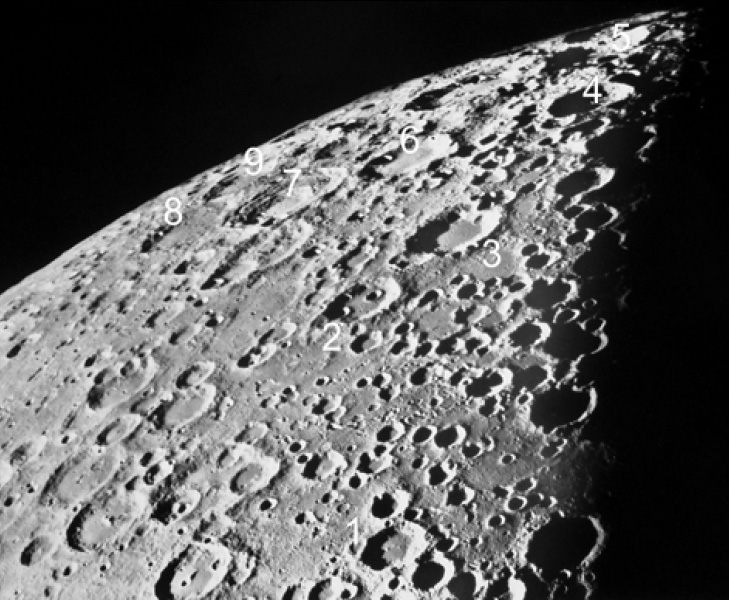
Figure 2 :
Southern limb of the 6-day-old Moon (South up)
1 Baco 2 Mutus 3 Manzinus 4 Schomberger 5 Scott 6 Boguslawsky7 Boussingault 8 Helmholtz 9 Neumayer
Image from the Consolidated Lunar Atlas maintained by the Lunar and Planetary Institute.
The chain curves southeast and then south, to point to MUTUS (Fig. 2, 2) across a flooded area that contains only small craters. It lies the same distance away as the length between Clairaut and Baco. Mutus like Clairaut has two small deep craters in its floor and in the same meridian close by to the south the larger MANZINUS (Fig. 2, 3) has its walls peppered by small craterlets. Further along the meridian towards the south pole and about the same distance as the combined lengths of the last two craters and the distance between them, SIMPELIUS is associated with four small craters at its north wall, the smallest forming a gutter between it and the middle member of the group, Simpelius E. The north south pair has a figure of eight appearance whose waist is compressed by the two east and west members. If the terminator is too close to the group it should be viewed later, but if the central mountain of MORETUS to its west can be seen in its dark floor, Simpelius lies half way on a shallow curve from it to MANZINUS. Towards the limb SCHOMBERGER (Fig. 2, 4), a larger crater, lies between Simpelius and SCOTT (Fig. 2, 5), a moderate sized crater that is closer to the limb. To the east, a small and medium sized crater separates Schomberger from the large BOGUSLAWSKY (Fig. 2, 6). Almost touching the latter, BOUSSINGAULT (Fig. 2, 7) has a small crater on its north wall whilst the former large crater has a small crater within its south east wall. These two craters form a ‘square’ with the nearby Mutus and Manzinus at their north. Slightly east and touching Boussingault’s south border, HELMHOLTZ (Fig. 2, 8) and its southwest companion NEUMAYER (Fig. 2, 9) closer to the rim to form a close triplet.
Favorable libration in negative latitude is needed to identify these structures and the LEIBNITZ MOUNTAINS that are projected from behind the limb in this area.
To view the area further north, return to M. Nectaris. A line west of the junction of CYRILLUS (Fig. 3, 1) and CATHARINA (Fig. 3, 2), crosses a small deep crater TACITUS (Fig. 3, 3) that has a central mountain.
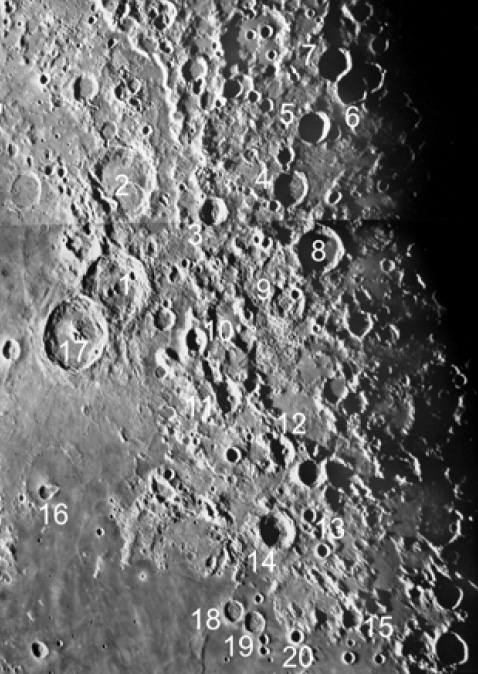
Figure 3 :
Central region of the 6-day old Moon (South up)
1 Cyrillus 2 Catharina 3 Tacitus 4 Almanon 5 Geber 6 Abenezra 7 Azophi 8 Abulfeda 9 Descartes 10 Kant 11 Zollner 12 Taylor 13 Theon Jnr & Snr 14 Delambre 15 d’Arrest 16 Torricelli 17 Theophilus 18 Sabine 19 Ritter 20 Dionysius
Images from the Consolidated Lunar
Atlas maintained by the Lunar and Planetary Institute.
Extending the line further west crosses ALMANON (Fig. 3, 4) that is easily recognized by the two small craters at its south wall that look like an old fashioned keyhole with another small craterlet lying at its north east border. From this at its northeast wall, a ridge extends south east towards the Altai scarp and to the west, south of ABULFEDA (see later). A string of small craterlets lie along this ridge. Almanon is part of a chain of craters lying on a curve concave to the west that begins at WALTER, south east of M. NUBIUM and ends at REAMUR at the south coast of SINUS MEDIA. Only the central part of the chain is visible tonight. South of Almanon, GEBER (Fig. 3, 5) is a smaller crater and following the curve to the south west, a triad of touching craters lies near it. ABENEZRA (Fig. 3, 6) the north member has a central mountain and invades a shallower crater ABENEZRA C at its west side, whilst AZOPHI (Fig. 3, 7) the south member of the three touches AZOPHI G a vase like structure whose south wall is open. Moving to the north of Almanon, ABULFEDA (Fig. 3, 8) the largest of the central group, has a polygonal shape and a slightly off centre mountain. North east of Abulfeda, DESCARTES (Fig. 3, 9) has a small crater at its south and south west wall and an absent north wall where a tiny craterlet`s impact has resulted in a large bright area at its site. Returning to M. NECTARIS, Cyrillus at its west coast has a small crater just inside its west wall that will develop a bright halo in the next few days. It lies south of a line of small craters running north and slightly west. The second and fourth members of the chain, KANT (Fig. 3, 10) and ZOLLNER (Fig. 3, 11) have small mountains, and after a short smooth gap the line crosses TAYLOR (Fig. 3, 12) and its companion A. The line turns to the north crossing the small THEON JUNIOR and its north relative THEON SENIOR (Fig. 3, 13) both lying west of DELAMBRE (Fig. 3, 14), a prominent thick walled terraced crater. The line ends at D’ARREST (Fig. 3, 15) a pear shaped crater due to a craterlet at its south edge. East of Delambre a short broad peninsula narrows the junction of M. Nectaris and M.Tranquillitatis where the small pearshaped TORRICELLI (Fig. 3, 16) lies closer to the east side of the strait. The irregular north coast of the peninsula passes west for a short distance then turns south forming a bay north of THEOPHILUS (Fig. 3, 17). In the sea at the south west angle of M.Tranquillitatis, lie the twin craters SABINE (Fig. 3, 18) and its west companion RITTER (Fig. 3, 19), pointing to the north west DIONYSIUS (Fig. 3, 20), a small coastal crater whose corona will brighten spectacularly to be a useful guide to the surrounding area. To its south west a small mountain is also a bright point.
Northern Hemisphere
The line from Sabine and Ritter at the southwest corner of M. Tranquillitatis crossing Dionysius, continues to the small CAYLEY (Fig. 4, 1) in the nearby west. It is the largest of a group of four craterlets lying north of the pear-shaped d`Arrest.
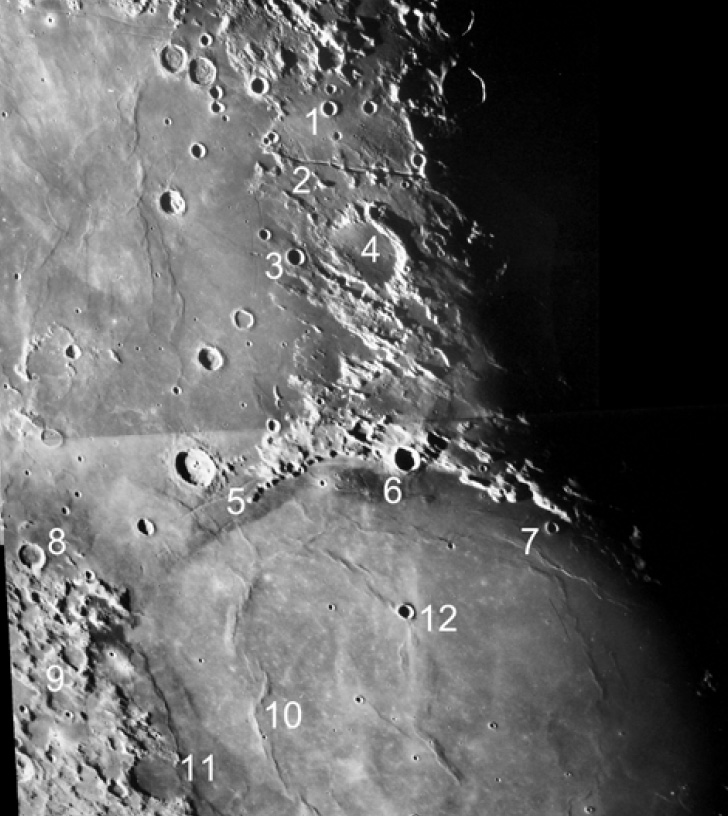
Figure 4 :
North-central region of the 6-day-old Moon (South up)
1 Cayley 2 Ariadaeus Cleft 3 Sosigenes 4 Julius Caesar 5 Cape Acherusia 6 Menelaus 7 Sulpicius Gallus 8 Vitruvius 9 Littrow 10 Serpentine Ridge 11 Monnier 12 Bessel
Images from the Consolidated Lunar Atlas maintained by the Lunar and Planetary Institute
A north line from this crater also crosses Cayley then crosses the ARIADAEUS CLEFT (Fig. 4, 2). The cleft is named after the pair of craterlets at the sea where the cleft begins. West of this cleft is the HYGINUS CLEFT, angled at its center, at the site of a small craterlet that gives it its name. Both clefts are best seen with oblique lighting, but the latter may not be seen until the following day. Further north along the coast and just off shore the small crater SOSIGENES (Fig. 4, 3) lies next to the large coastal horseshoe shaped JULIUS CAESAR (Fig. 4, 4) whose southeast wall has been destroyed. It has a dark patch at the north part of its floor that is similar to the floors of several craters nearby and to the floor of the west sea M.Vaporum. North of the crater, the coast line is indented by an irregular bay where it changes direction to the east ending at CAPE ACHERUSIA (Fig. 4, 5). The dark lava flow from the north floor of M.Tranquillitatis ceases at a line just north of the strait, but continues along the coasts of M.Serenitatis. The west coast of the M.Serenitatis can be divided into three sections. The first beginning at the Cape Acherusia passes west for a short distance then the second section slowly arches to the north where the short third section ends at CAPE FRESNEL. Off shore at the first portion, the small craterlet TARQUET will be seen in the dark coastal strip; whilst near by where the coast changes direction, MENELAUS (Fig. 4, 6) at the coast stands out early in the lunar day because of its height at the shore of the HAEMUS MOUNTAINS that borders the coast. To the west the larger MANILIUS in M. VAPORUM with its central mountain will also have its ramparts lit. The mountain’s coast is quite precipitate and a small bay just south of the small coastal craterlet with a big name, SULPICIUS GALLUS (Fig. 4, 7), shows this extremely well. The short last section lies and faces east of the APENNINE MOUNTAINS but only the north part of the range is visible tonight. Across the strait that joins the sea to M. IMBRIUM, only the south end of the CAUCASIAN MOUNTAINS (Fig. 5, 1) can be seen. However at this period, they show as three blocks.
East of the strait, the controversial LINNE shows as a small white spot, whilst to its west, several crater’s ramparts stand out in the darkness west of the terminator. The two ranges point north to EUDOXUS (Fig. 5, 2), a moderate sized crater with the larger polygonal ARISTOTELES (Fig. 5, 3) further north, both having terraced walls and small mountains scattered in their floors.
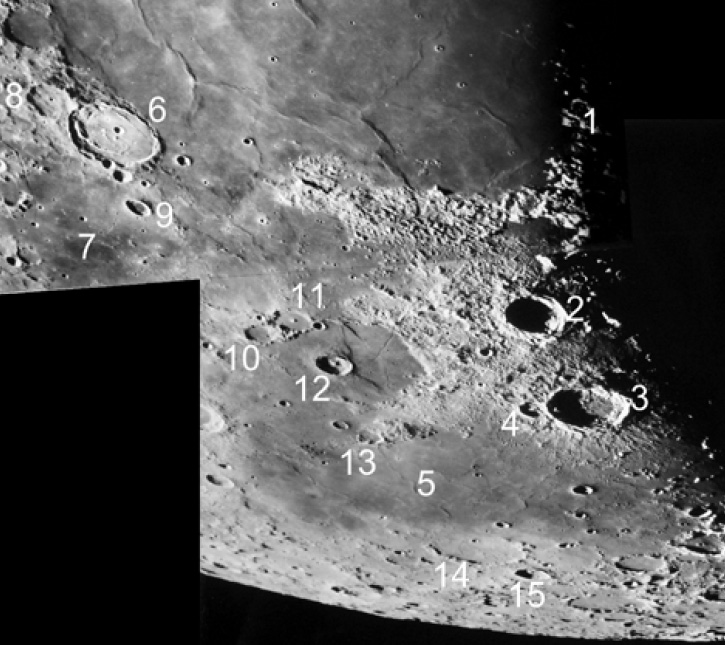
Figure 5 :
Northern limb of the 6-day-old Moon (South up)
1 Caucasian Mtns 2 Eudoxus 3 Aristoteles 4 Mitchell 5 Mare Frigoris 6 Posidonius 7 Lacus Somniorum 8 Charcornac 9 Daniell 10 Mason 11 Plana 12 Burg 13 Baily 14 Gartner 15 Democritus
Images from the Consolidated Lunar Atlas maintained by the Lunar and Planetary Institute
Aristoteles has a small crater MITCHELL (Fig. 5, 4) near its east border. A north line through both large craters crosses M. FRIGORIS (Fig. 5, 5), passing east of the large clover leaf like METON near the limb, that may be seen if libration is favourable.
Opposite Cape Acherusia, the east cape is represented by MOUNT ARGAEUS that at low lighting casts a shadow to the west. In the small peninsula east of the mountain, three small dark floored shallow craters give the appearance of a surprised ghostly face. The west VITRUVIUS (Fig. 4, 8), and its dark floored east companion MARALDI, lie at the south end of the peninsula, whilst LITTROW (Fig. 4, 9) shaped like an electric light globe due to a craterlet at its north end, lies north of Mt. Argaeus at the coast. Further east the wellformed ROMER with a central mountain is the largest obvious mountain in the TAURUS MOUNTAINS. A ridge from the Argaeus mountain passes north in the dark coastal area to POSIDONIUS, whilst offshore is the long SERPENTINE RIDGE (Fig. 4, 10) entering the sea west of Plinius to continue parallel to the east shore of M.Serenitatis where west of Posidonius it divides into two, but early oblique lighting is needed to observe the ridge. More than half way along the coast, MONNIER (Fig. 4, 11) a deep circular bay open to the sea was probably a crater whose western wall was destroyed by the lava flow that filled its floor. A south west line from Monnier crosses BESSEL (Fig. 4, 12) a small crater near the centre of the sea where a ray from Menelaus crosses it to continue as part of the round the moon ray. The large oval distinctive POSlDONIUS (Fig. 5, 6) at the north end of the east coast of the sea, juts out into the junction of M. Serenitatis and LACUS SOMNIORUM (Fig. 5, 7). It is an obvious landmark and has some interesting features. In its floor and concentric to its walls, a broken ridge runs near its east south and west walls to end as a rill. At low lighting, a break in the west wall, allows light through to the seas floor and a small craterlet is seen at its centre. CHARCORNAC (Fig. 5, 8), a smaller polygonal crater to the south of Posidonius, is separated from it by a small craterlet. From the northeast wall of Posidonius, a short series of small craters lead to the oval DANIELL (Fig. 5, 9) in Lacus Somniorum and to GROVE at the lakes north shore. From the latter crater, a ridge passes northwest to the fused walls of MASON (Fig. 5, 10) and the larger west PLANA (Fig. 5, 11). Both have low broken walls and Plana has a small central mountain with a craterlet at its crest. They are at the south of LACUS MORTIS with BURG (Fig. 5, 12) a deeper structure with an obvious mountain in its floor, lying at the middle of the sea. The west coast of the sea is a scarp; whose face is brightly lit, and the reference line from Atlas to Eudoxus crosses Burg and the scarp. The lake joins M.FRIGORIS through a narrow strait with the small BAILY (Fig. 5, 13) at the west side of the junction.
A north line from Burg through Baily crosses the sea to GARTNER (Fig. 5, 14), a large shallow crater at its north coast that at some days may be difficult to find, but a little north of its west end, the small but more obvious DEMOCRITUS (Fig. 5, 15) should be noted as it begins a chain of similar craters useful for a guide to the polar region.